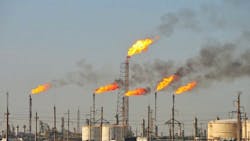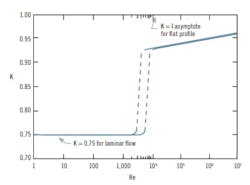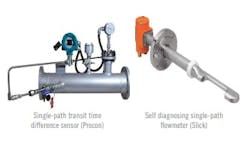Q: I’d like to select a flowmeter for a 28-in. pipe at the flare outlet (waste gas). The range is wide—100 kg/h to 245,000 kg/h. My suggestion is to use a thermal mass flowmeter, but I’m afraid it won’t have sufficient rangeability.
Please help me select the right flowmeter.
Rahim Salamat, process control engineer / [email protected]
A1: Methane is a primary component of natural gas, and is responsible for up to a third of global warming caused by human activities. It’s short-lived in the atmosphere (about 10 years) but is 25 times more powerful than carbon dioxide, and without serious action, global methane emissions are projected to rise 13% by 2030. Today's concentration in the atmosphere is about 2.0 ppm. At a United Nations conference in Dubai, 103 emitter countries signed the Global Methane Pledge, which aims to reduce methane emissions by 30% compared to 2020 levels.
In 2022, Stanford University researchers found that in some natural gas producing regions, 9% of the methane in flare gas escaped into the atmosphere. This finding suggests that global methane emissions are much higher (possibly five times) than estimates in published literature or by the U.S. Environmental Protection Agency (EPA) at 1.4%. In the past, oil and gas producers assumed that flaring of natural gas from their facilities (Figure 1) burned 99% of the vented gas, but Stanford’s research shows flaring is far less effective than previously thought.
Today, global methane emissions are still rising, and their concentration in the atmosphere is the highest it’s ever been, having increased by more than 10% during the past two decades. For these reasons, the need for the accurate measurement of flared gas flows and compositions have increased, resulting in improvements in sensors that measure flare flows.
Now, concerning flare mass flow measurement over a range of 2,500:1 in a 28-in. diameter pipe, you’re correct that thermal flowmeters aren’t suitable because of size, rangeability and contamination considerations. For your type of applications, the most often used detectors are transit-time, ultrasonic sensors.
Ultrasonic frequency is beyond human hearing (more than 20,000 Hz). Differential transit time, also referred to as time of flight (TOF)-type ultrasonic detectors, measure the difference in the travel times of ultrasonic pulses as they traverse an interior pipe section, both with and against the direction of flow (Figure 2, left). The longer the travel distance of the pulses (Figure 2), the better the time resolution and the accuracy. There are both single and multipath TOF sensor designs, and their transit times are measured in nanoseconds and picoseconds.
The flow velocity (V) is determined as the average of the velocity profile, which is flat under highly turbulant conditions and becomes unpredictable in the transition zone (under RE=10,000). The acoustic path length (L) is a function of the path patterns (Figure 2, right), while (ɵ) is the angle of pulse path relative to the pipe (a) axis. The product of velocity and area gives volumetric flow.
- RE is a function of the fluid composition because the speed of sound is a function of that. RE is also a function of both ambient and fluid conditions during both calibration and operation.
- Fluid property changes including pressure, temperature, density and many other variables, including pipe ovality and inner surface quality, in up and downstream straight runs also influence RE and therefore the K factor.
Because only the transit times were measured in early designs, while the other process variables were only estimated constants, these meters were low accuracy (±1% at full scale) and low rangeability (10:1). The main reason why accuracy and rangeability of today's detectors (Figure 4) increased drastically is because the accuracy of measuring TOF improved by orders of magnitude. In addition, using more sensors helped increase the accuracy of the meter constant K, and the use of sophisticated proprietary algorithms made it feasible to calculate flare gas molecular weight and mass flow.
I believe suppliers' claims of up to 4,000:1 rangeability at flow measurement accuracies of 2% to 3% over that range are exaggerated. I don’t believe that measuring volumetric flow velocities from 0.03 to 120 m/s (0.1 to 394 ft/s) is feasible without dropping into the RE transition zone. Also, the velocity profile is likely to be disturbed by probe-type designs. The angle (ɵ) of the pulse path isn’t likely to be that accurate and calibration (if any) is questionable. In fact, I’m not certain that calibration facilities for all flow cells (sizes 1 in. to 98 in.) are available (Figure 4).
My advice is to install one of these flow cells, and not worry about their not living up to claimed performance because they’re still better than any others, and nobody has a sensor to debate their accuracy at low RE.
Béla Lipták / [email protected]
A2: Better than 1:100 is difficult to achieve without big loss in accuracy.From a cost point of view and for similar accuracy, I recommend using ultrasonic flowmeters for such big pipelines.
Dr. H. S. Gambhir, professor / [email protected]
About the Author
Béla Lipták
Columnist and Control Consultant
Béla Lipták is an automation and safety consultant and editor of the Instrument and Automation Engineers’ Handbook (IAEH).

Leaders relevant to this article:




